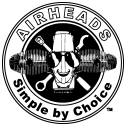Tuning carb needles
Hello,
Brand new club member here. I'm curious about people's experiences with different needles and settings, especially on a /6 with 32mm carbs.
I recently rebuilt the carbs on my newly-acquired 1976 R90/6 and had trouble with the engine bogging down and losing power until I set the slide needles at the 2nd, rather than stock 3rd position. I forgot to check, but that must have been where the PO had them as the bike is now running as smooth as it was before.
What are the possible reasons that the bike runs better with the needle one up from stock position? I am in Salt Lake City and running at around 4-6k feet.
I have read various resources including Snowbum's site but I haven't found any systematic guide to changing carb needle settings. I know that moving the slide needle one position is a fairly crude lean adjustment and so I'm curious what effect moving down a needle jet size or two would have instead. Will I see effects on both power and fuel consumption? Is it worth experimenting with the main jet as well? This summer, I will be moving back the east coast where I will be at sea level.

You'll definitely want to retune to sea level when you get back to NS. Sadly I don't know nearly enough to help you. Can you google general carb tuning for elevation? You should be able to find general needle setting ideas pretty easily.
As a starting point, you can go to bingcarburetor.com, then select “Motorcycle CV - type 64 & 94”, then near the bottom of the page there is a download “Bing Jetting Chart”. That chart will give you the factory jetting by carb number, including needle jet size and needle position, and main jet. Always a good place to start.
The needle jets are available in .002 increments like .264, .266, .268, .270. The needle jet size is the “fine adjustment”. There were also different needles used over the years, so might bear checking if you have the stock needle. The needle position 1-4 is more the “gross adjustment”. According to Snowbum, I believe, 1 increment change in needle position is equal to a 3 increment change in needle jet size.
Bottom line, if you try the factory settings and it seems too rich at your altitude, I would step down the needle jet size to fine tune. However, these CV carbs seem pretty good at self-compensating for altitude. Dropping the needle position might be a bit drastic, but I’m no carb tuner.
It is hard to know what POs have tweaked and changed, so starting at factory configuration is always good, IMHO. I wouldn’t fool with the main jet (if it is correct to the chart), as that only comes into play at very high speeds / rpm’s.
Thanks for the advice and for suggesting that chart. I should have mentioned that the needle jets were at 2.68, stock. I replaced both the needle jets and jet/slide needles with new stock ones.
The bike is running fine now with the needles at 2nd position but I'm just curious if there's a more optimal tuning, and if so how I can measure that in terms of observed power, mileage, or lean/rich condition.
When I get down to lower elevation, I will experiment with switching the slide needle back to 3rd position, and swapping in 2.66 jets.
Some thoughts...
- My take is this: People make WAY TOO much of "main jet size". The bike only runs on the Main Jet when: 1. the throttle is 7/8 to wide open, AND 2. the engine RPM reaches near max. For instance: If you are riding at 50MPH in top gear and open the twist grip all the way, then you are not on the main jet. The reason for this is that the throttle merely controls the butterfly valve, and not the slide. The slide has to be all the way at the top before the Main Jet comes into play. When that simple fact is understood, then it's easy to understand that 98.7% of your riding is done on the needle AND needle jet. Therefore, 98% of your efforts should focus on the needle and the needle jet. So unless you are tuning for the Bonneville Salt Flats, any talk of Main Jet size is usually unwarranted.
- Due to the air pulsing in the intake tract, the needle and needle jet get beat against each other during use. On any 50 year-old motorcycle, the first step in doing ANY carb tuning is to replace these 2 items on both carbs. Period. You simply cannot "tune jetting", when the jets themselves have been enlarged due to age.
Replacing these parts also corrects any corrosion that may have altered the precise shape of the needle or jet due to the use of ethanol fuels, which have been with us for ~30 years.

- When any tuning involves manipulation or adjustment of the needle position, due to the way this is done "blind" on the Bing, it is always a good thing to compare needle extensions to insure they are the same on both carbs before returning the side to the body. This is easily done with the depth gauge of a caliper as shown below. I have had customers report all sorts of poor running only to find the needles at different heights.

- You will typically be far better off to use the needle clip position listed in the Bing data, and change (usually increase) the needle jet size. You can consider the clip position to be a "gross" adjustment and the jet size to be the "fine" adjustment. Small adjustments are always a better first step rather than big ones.
Owning an old Airhead is easy.
Keeping an old Airhead running great is the true test.
- 27 Forums
- 1,900 Topics
- 10.8 K Posts
- 6 Online
- 5,936 Members




